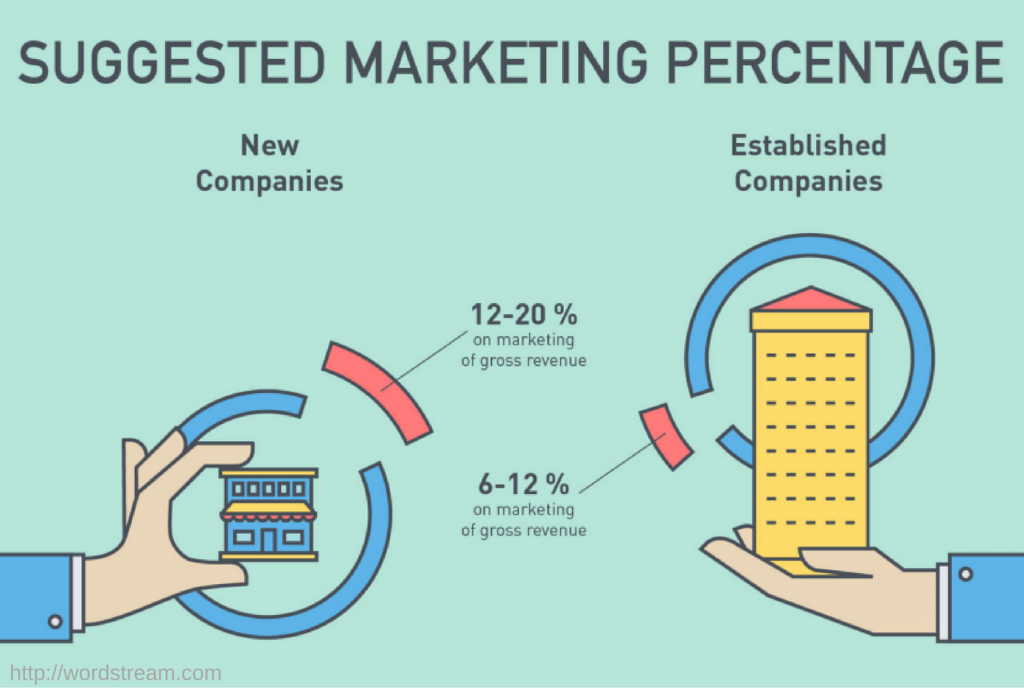In 2019, marketing is not something that your company does.
Today, every business is in the marketing business. Companies that fail to recognize the shift in how brands engage with customers in the digital world will find it hard to stay relevant. As attention spans shorten, brands are fiercely creating and promoting content on platforms that their customers prefer.
That is why the most successful companies are those that operate like media houses.[1] This approach to content creation and distribution proves extremely cost-effective in the long run.

This graphic from 2017 demonstrates the adage “money follows eyeballs”[2]
What this requires is a stellar digital marketing strategy, and one of the crucial steps in the process is setting up an online marketing budget. Today, we explore the major steps and best practices of making an online marketing budget.
Why You Need a Marketing Budget
Regardless of business size, marketing is essential to profitability and growth. But even then many businesses, especially small businesses, are still not spending enough on marketing. Conversely, while many companies do have a budget in place, they are not spending it efficiently. There’s a difference between the two, and we will try to cover both topics in this article.
Another misconception that many business owners still have is that they don’t need to spend money on digital marketing. Social media platforms and many marketing tools are free, so why spend money on them, right?
WRONG!
Research shows that 95% of companies are increasing spending on online marketing, and will continue to do so in the coming year as well.[3]
So, you need to invest in marketing, and you need to do it wisely. With that covered, let’s now get into the specifics of planning your budget.

1. Set Your Goal
Before getting into the numbers game, it is critically important to answer the ‘why’ question. If you don’t have a clear, concrete goal(s) in place, then it is very likely you’ll end up wasting both your time and money.
It’s a common situation: a company creates a great product or service that looks like a sure winner. But this is done in isolation without any input from the PR and marketing departments. Come launch time, the company has a great product to offer, but no marketing plan or promotional materials to spread awareness. The company may reach out to marketing agencies, PR firms, or consultants in desperation, only to incur additional costs that may or may not bring in the desired results.
If you want to avoid this situation, you need to first set up clear marketing goals from the get-go, even during the production if that’s possible. You want to decide where to see your results, which can be one or many. Examples include:
● Boosting brand awareness
● Creating brand loyalty
● Increasing qualified leads
● Growing a mailing list
● Increasing enrollment to a live event like a seminar
The more specific your goal, the better. This also helps you decide what tools and skills you need, which increases accuracy in budgeting. Let’s move on…
2. Tap into the Past
Part of forecasting the future involves learning what has worked in the past. This also includes competitor analysis, especially if you are a new business.
Do you have prior experience with digital marketing? Was it effective?
While vision and creativity are essential business skills, you should always give preference to what the data tells you. If something has worked in the past, then stick with it.
3. Look to the Future
With digital marketing, looking to future is as important as analyzing the past. Think about it. Most of the marketing tools you use today didn’t even exist a couple of years ago. And now, you can’t do without them. This is especially true of social media platforms like Facebook, Twitter, and Instagram. These channels started with a handful of followers, and today, entire companies base their revenue stream on these platforms.
Now, let’s talk numbers, shall we?
4. Budgeting Based on Company Size
Rule of thumb suggests that your company size determines your marketing budget (though that’s not always true). The Small Business Association (SBA) suggests that small businesses with less than $5 million revenues should allocate up to 8% of their revenues to marketing.
This budget should be divided equally, for the most part, between:
● Brand development
This includes the costs of all channels you use to boost your brand, such websites, blogs, social media etc.
● Business Promotion
This includes the costs of your advertising, campaigns, events etc.
SBA’s estimate applies to businesses with profit margins of 10%-12% after covering expenses, including marketing. Your marketing budget should never be based on what’s left after other expenses are covered (see point #5). Again, brands who treat marketing as an afterthought are setting up for long-term failure.
If your profit margins are lower than 10%, then you can consider lowering your overall margin, and freeing up some costs to spend on marketing. This may seem counter intuitive, but remember that your business wouldn’t survive without marketing.
A lot depends also on your companies growth stage. Are you starting out, or seeking to expand? Generally, you need to allocate a greater percentage to marketing during the early years of your brand, up to 20% of sales. As your brand develops and gains recognition, you don’t need such a high percentage.
5. Budgeting Based on Expected Profits
The graphic below will give you a glimpse of how to budget your marketing based on your expected gross revenue (i.e. profit before deducting expenses)

Source[4]
Let’s assume that you’re a 2-year old startup with 10 employees making a yearly gross revenue of $50,000. That means you should be allocating $6000 to $10000 for marketing. But if you’re an 5-year old established company with brand equity/market share, then you can even manage with $ 3000-$6000.
As we mentioned above, established businesses don’t need as much marketing as new ones do. They already have loyal customers, and their initial marketing efforts are now reaping the rewards.
[1] Why Every Company Is Now a Media Business, May 31, 2018
[2] How Ad Spending Aligns With Media Consumption, Felix Richter, May 15, 2018
[3] 20/20 Vision: A Marketing Leader’s View of Digital’s Future, https://digitalmarketinginstitute.com/campaign/business/20-20-vision-a-marketing-leaders-view-of-digitals-future[4] How to Calculate Your Marketing Budget [Infographic], April 27, 2018 https://www.wordstream.com/blog/ws/2016/10/26/marketing-budget
By Brandi Mercene

Have questions about press release distribution, or any of our other services? Our team at PR Distribution™ is ready and happy to help through email, live chat, support tickets and phone! Contact us


